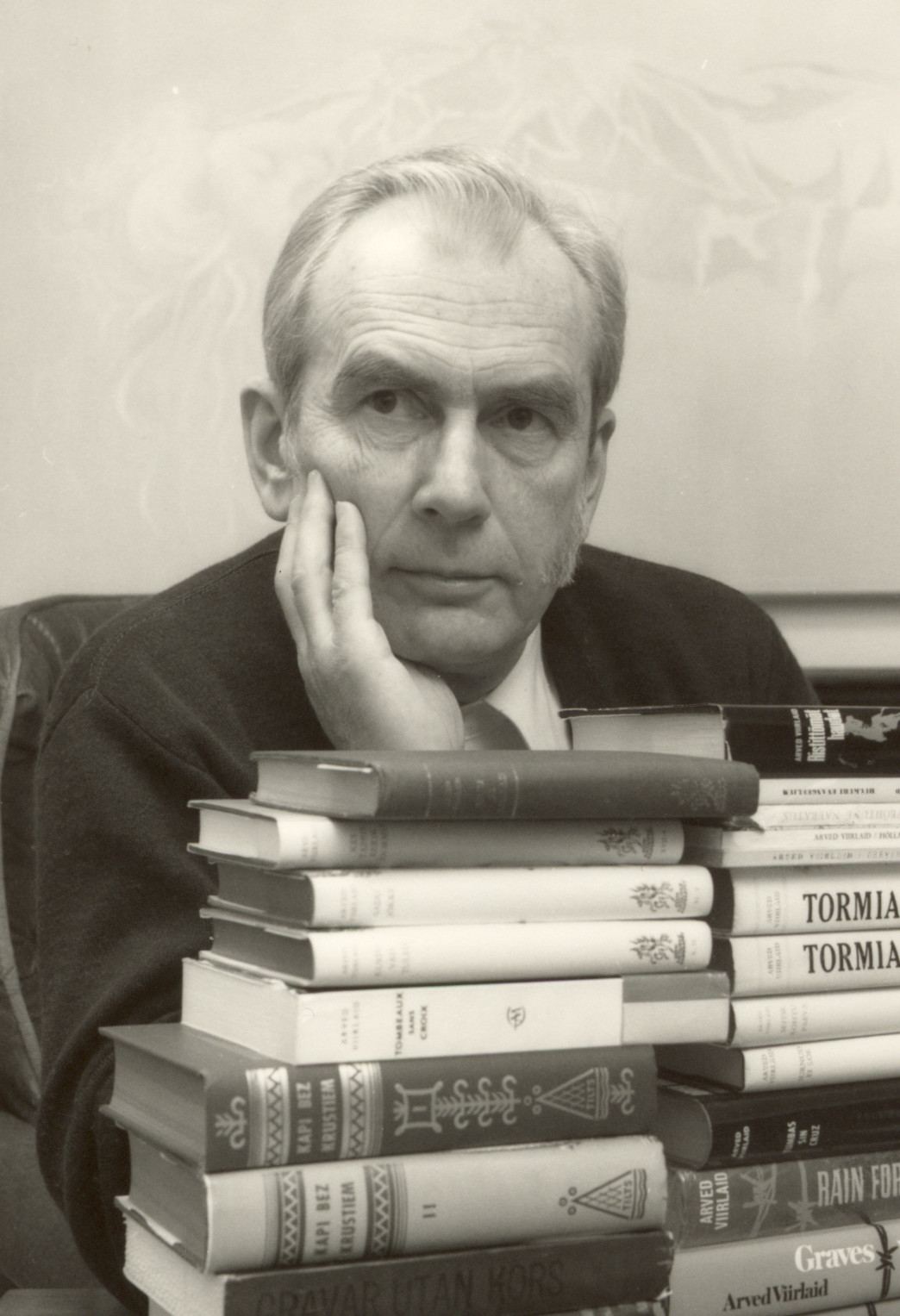
Arved Viirlaid
Arved Viirlaid (11. IV 1922 – 21. VI 2015) was an Estonian prose-writer and poet, known chiefly for his novels of war and exile, earning the status of an ideologically nationalist writer for his popular and much-translated novel Ristideta hauad (‘Graves Without Crosses’, 1952).
Viirlaid was born in 1922 as the son of a farming family in the Padise district of Harjumaa county. From 1937 to 1941 he studied at the Tallinn School of Applied Art. During the German occupation he worked as a technical editor for the publishing house Tallinna Eesti Kirjastus-Ühisus. From 1941 to 1944 he fought as a Forest Brother guerrilla and Finnish recruit against Soviet troops. He returned to Estonia from Finland in August 1944, fighting on the German side. In October 1944 he fled by boat to Finland, and onward to Sweden. After the war he lived for a short time in Sweden, from 1945 to 1953 in England, where he held various jobs, and from 1953 in Canada, working until his retirement in a printing-house. Alongside his daily work he was a creative writer. For a long time he was the chairman of the Estonian PEN Club. He was a member of the Estonian Writers’ Union Abroad (from 1950), Estonian National Central Council, the Estonian Central Council in Canada and the Estonian Officers’ Association. In exile he repeatedly won the Henrik Visnapuu Literature Prize (1954, 1979, 1981, 1992). He received the Virumaa Literary Prize for the work Märgitud (‘Marked’, 1991). In 1997 President Lennart Meri awarded him the Order of the National Coat of Arms of Estonia, III class, but the writer refused to accept it. Viirlaid died at his rural home near Toronto.
He began his literary career as an outstanding poet. Viirlaid was one of the pioneers of war poetry in exile. His first poetry collections feature reflections on the war years and life in exile, as well as the theme of love. In his later poetry, reminiscence is the primary material, with an increase in the epical mode of expression.
He became known as a prose writer. As a representative of the betrayed generation, his task proceeds from a firm ethical principle: to tell the world the truth about what happened in Estonia during the Second World War and afterward. In his novels Viirlaid described the events of the war in Estonia, during the changes of occupation, about the Forest Brothers, the actuality of the Soviet prison camps and the problems of life in exile society. Because of his radical nationalist views and his uncompromising anti-communist stance he was a totally banned author in Soviet Estonia. He published 10 novels, two prose collections and eight collections of poetry, most of his work appearing abroad and finding its way to Estonia with difficulties and delays.
Viirlaid’s first substantial prose work, the novel Tormiaasta (‘Year of the Storm’, 1949), written in the London internment camp, tells of the events of the war in 1944 in Estonia. His major work, rich in characters and intrigues, the epic of the Forest Brothers called Ristideta hauad, I-II, (‘Graves without Crosses’, 1952), takes the reader back to the beginning of the Soviet occupation of Estonia, the autumn of 1944, when many Estonians had to hide in the forests, by way of armed resistance to the occupation forces. With heroic pathos, this realistic novel tells of the occupied nation’s will to free itself, of the Estonians’ hopeless struggle, full of disappointment, for their homes and lives. The novel Seitse kohtupäeva (‘Seven Days of Judgment’, 1957) communicates the nightmarish images of exiled writer, the protagonist, in the war years and the complex contacts with the realities of life in exile. The course of the Estonian cause in Estonia and in exile is dealt with in a cycle of five novels Vaim ja ahelad (‘Spirit and Chains’, 1961), Kustuvad tuled (‘Dying Lights’, 1965), Sadu jõkke (‘Rain for the River’, 1965), Kes tappis Eerik Hormi? (‘Who Killed Eerik Horm?’, 1974); Surnud ei loe (‘The Dead Don’t Count’, 1975), unified by the figure of the Estonian officer Eerik Horm, a freedom fighter. The documentary novel Märgitud (‘Marked’, 1980), examines the tragic fate of the Finnish Boys or Estonian infantry regiment no. 200 in the Finnish army during the Second World War. The autobiographical novel Põhjatähe pojad (‘Sons of the North Star’, 2009) deals with the struggle of the betrayed generation in Finland and Estonia from spring 1943 to the flight to Sweden in autumn 1944. Viirlaid’s socially significant short prose adds episodes to the material covered in the novels.
A. O. (Translated by C. M.)
Books in Estonian
Poems
Hulkuri evangeelium. London: Dragon Press, 1948, 96 lk.
Üks suveõhtune naeratus. London: [s.n.], 1949, 96 lk.
Jäätanud peegel. Lund: Eesti Kirjanike Kooperatiiv, 1962, 95 lk.
Hõllalaulud. Lund: Eesti Kirjanike Kooperatiiv, 1967, 95 lk.
Käsikäes. Lund: Eesti Kirjanike Kooperatiiv, 1978, 94 lk.
Igaviku silmapilgutus. Lund: Eesti Kirjanike Kooperatiiv, 1982, 112 lk.
Valgus rahnude all. Lund: Eesti Kirjanike Kooperatiiv, 1990, 96 lk.
Elada antud on elu. Toronto: [s.n.], 1993, 39 lk.
Novels
Tormiaasta. I–II. Vadstena: Orto, 1949, 365+421 lk.
Ristideta hauad. I–II. Lund: Eesti Kirjanike Kooperatiiv, 1952, 367+360 lk. [Järgnevad trükid: Tallinn: Perioodika, 1991, 238+360 lk; Tallinn: Eesti Päevaleht, 2009, 522 lk; Tallinn: Hea Lugu, 2015, 519 lk.]
Seitse kohtupäeva. Lund: Eesti Kirjanike Kooperatiiv, 1957, 347 lk.
Vaim ja ahelad. Lund: Eesti Kirjanike Kooperatiiv, 1961, 343 lk. [Järgnev trükk: Tallinn: Virgela, 1998, 325 lk.]
Kustuvad tuled. Lund: Eesti Kirjanike Kooperatiiv, 1965, 275 lk.
Sadu jõkke. Lund: Eesti Kirjanike Kooperatiiv, 1965, 260 lk.
Kes tappis Eerik Hormi?. Lund: Eesti Kirjanike Kooperatiiv, 1974, 285 lk.
Surnud ei loe. Lund: Eesti Kirjanike Kooperatiiv, 1975, 276 lk.
Märgitud. Lund: Eesti Kirjanike Kooperatiiv, 1980, 220 lk. [Järgnev trükk: Tallinn: Perioodika, 1990, 220 lk.]
Põhjatähe pojad. Tartu: Ilmamaa, 2009, 253 lk. [Järgnev trükk: Tartu: Ilmamaa, 2010, 461 lk.]
Short stories
Saatuse sõlmed. Lund: Eesti Kirjanike Kooperatiiv, 1993, 248 lk. [Järgnev trükk: Tallinn: Eesti Raamat, 1994, 166 lk.]
Ajal on mitu nägu. Tartu: Ilmamaa, 2005, 462 lk.



